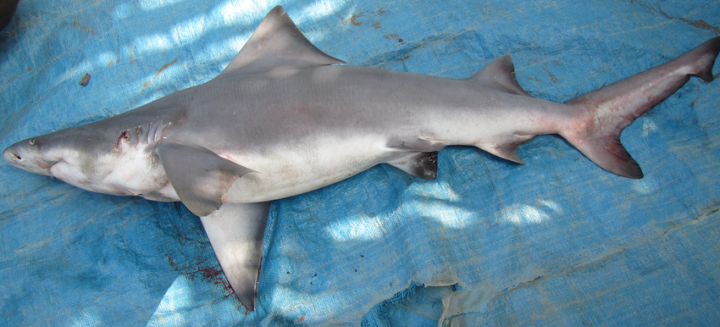Sharks have been around for over 450 million years. The earliest tree lived 350 million years ago. Sharks are older than trees and the only animal to have survived all five mass extinctions.
Sharks are the ones who have made our oceans richer through their evolutionary process. Sharks are apex predators, which means they are the highest-ranking animals in the food chain. They help to maintain the species below them and keep the ecosystem healthy.
Some of them will make you smile, while others may send you running for your life. For more information about the seven oceans, check out the Facts About the Waves That Will Blow Your Head.
Find out our top Glyphis shark facts!
Amazing Facts About Sharks

1. Sharks don’t have bones.
Sharks filter oxygen out of the water using their gills. They are a particular type of fish called “elasmobranchs,” meaning they are made from cartilaginous tissue, the clear gristly material that your ears and nose tips are made of. Also included in this category are skates, sawfish, rays, and sawfish. Their cartilaginous bones are lighter than real bone, and their large livers contain low-density oil, which helps them be buoyant.
Sharks do not have bones, but they can still fossilize. To strengthen their skeletal cartilage, most sharks deposit calcium salts as they age. The shark’s dried jaws feel like bone and are heavy. These minerals are what allow shark skeletal systems to fossilize very well. Because the teeth are enamelled, they also show up in fossil records.
2. The majority of sharks can see well.
Sharks can see in dimly lit areas and see colours well. A reflective layer of tissue is found behind the shark’s eyeballs, called a tapum. This allows sharks to see even in low light conditions.
3. Special electroreceptor organs are found in sharks.
Small black spots are found near the nose, eyes, and mouth of sharks. The ampullae de Lorenzini are special electroreceptor organs that enable sharks to sense temperature changes in the ocean and electromagnetic fields.
4. Sharkskin is similar to sandpaper.
Platinoid scales are tiny, tooth-like structures that make shark skin feel like sandpaper. Also known as dermal denticles, they are also called dermal denticles. These scales are oriented towards the tail and reduce friction in the surrounding water as the shark swims.
5. Sharks can go into a trance.
Flipping a shark upside-down causes them to enter a state of tonic immobility, similar to a trance. This is why you see sawfish often flip over while scientists work on them in the sea.
6. Sharks have existed for a long time.
Scientists believe sharks first appeared in oceans around 455 million years ago, based on fossil scales from Australia and the United States.
7. Scientists can age sharks using the rings found on their vertebrae.
Vertebrae have concentric pairs that are both opaque and transparent. Scientists assign an age to sharks based on the number of band pairs. Band pairs are counted in the same way as rings on a tree. If the vertebrae have 10 band pairs, then it is presumed to be 10 years of age. However, recent studies have shown that this assumption may not be correct. Because the deposition rate can change over time, researchers must study each species and every size class. Validation is the process of determining the rate at which bands are being deposited.
8. Blue sharks are blue.
The blue shark has a bright blue colour on its upper body, but it is usually snowy white below. Although the mako- and porbeagle sharks have a similar blue colouration to blue sharks, it is less striking than blue sharks. Most sharks in life are either brown, olive, or greyish.
9. Every spot pattern of a whale shark is as unique as a fingerprint.
The largest fish in the ocean is the whale shark. Some estimates put their size at around 12.2 meters. They can also weigh up to 40 tons. Basking sharks, which can grow to 32 feet in length and weigh more than five tonnes, are the second-largest fish globally.
10. Different sharks may have different teeth.
Mako sharks are known for their sharp teeth. White sharks, on the other hand, have triangular, serrated, pointed teeth. Each prey leaves a distinctive, telling mark. Over its lifetime, a sandbar shark can have approximately 35,000 teeth!
Glyphis Shark Facts

This collection of glyphis shark facts will help you learn more about endangered and lesser-known tropical shark species.
1. Glyphis sharks are also known as river sharks.
2. Glyphis is one of the geniuses in the Carcharhinidae family.
3. Glyphis sharks can be considered freshwater sharks.
4. Known species have been identified in Australia, South Asia, Sout-East Asia, Papua New Guinea, and elsewhere.
5. Four species are part of the glyphis river shark genus: Glyphis gangeticus; Glyphis garricki; Glyphis glyphis; and Glyphis siamensis.
6. All of them are endangered and rare sharks.
7. The appearance of each species is similar, with a wide-body, either brown or grey, prominent dorsal Fin, small eyes, and sharp teeth.
8. Bull sharks can sometimes be confused with glyphis rivers sharks. They can live in some freshwater habitats but are not part of the glyphis species and are not true freshwater sharks.
9. Bull sharks can be aggressive, but glyphis river sharks tend to avoid humans and are generally peaceful.
10. Glyphis sharks do not lay eggs like fish; female sharks develop embryos within their bodies just like mammals.
11. Humans pose a threat to glyphis river sharks in many ways. These include illegal and commercial net fishing, dam construction, mining, and water programs.
12. Glyphis have tails, a river shark species from Great Britain that is now extinct. It was closely related to modern-day Ganges sharks and spear tooth sharks.
Wrapping Up:
Hope you loved exploring these glyphis shark facts with us!!! Get to know more amazing facts about such rare species just like the glyphis here!!
Stay tuned and share the post with your loved ones!!
